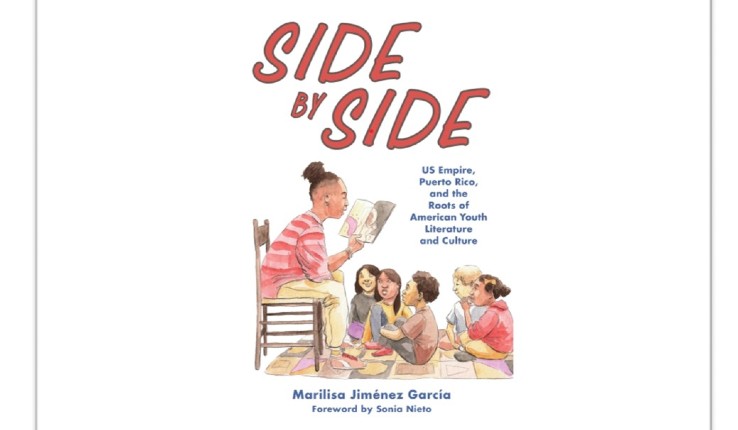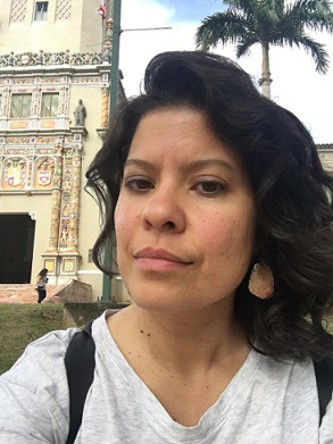The term “side by side” refers to closeness or friendship, a common theme in youth literature. In the context of Jiménez Garcia’s scholarship, the term highlights the tension that exists between the U.S. and Puerto Rico, a colonial relationship where the idea of “side by side” highlights what is unresolved and “awkwardly ambiguous,” much like the two flags which, says Jiménez Garcia, “fly side by side everywhere you go in Puerto Rico.”
“Representations of closeness and universality in youth literature and culture are often a guise for colonial violence and tie to deeply embedded, interrelated notions in U.S. culture about race, literacy, embodiment, language and, ultimately, citizenship,” writes Jiménez Garcia in Side by Side’s introduction.
The island now known as Puerto Rico was inhabited by the indigenous Taíno population for at least 1,000 years before explorer Christopher Columbus claimed it as a Spanish territory in 1493. The Taíno called the large Carribean island Borinquén, and referred to themselves as boricua, a term that is still used today. Spain ceded the territory to the U.S. in 1898, along with Guam, the Philippines and Cuba, after the Spanish-American War. Puerto Rico remains an unincorporated territory of the U.S. today.
The first chapter, “Indescribable Beings: Reframing a History of Empire and Priming the Public in Illustrated Youth Texts,” explores how 20th century U.S. authors writing for children portrayed Puerto Ricans and the relationship between the island and the U.S. Jiménez Garcia argues that authors relied on old tropes and stereotypes of an insensate and will-less people, lacking in their own culture.
She writes: “Children’s literature was part of a larger colonial project to narrate the twentieth-century U.S. empire as the benevolent conqueror of an archipelago void of history. Simultaneously, children’s literature through the form of picture books and illustrated primers functions as more than a process of ethnography, but as a visual dictionary that both documented and defined Puerto Rico and Puerto Ricans as unsuitable for citizenship on the same level as white U.S. continental citizens.”
The second chapter, “From the Ground Up: Pura Belpré, Arturo Schomburg, and Afro-Boricua Pedagogies of Literacy and Resistance,” delves into how Puerto Ricans in the diaspora resisted and kept Puerto Rican culture and stories alive, particularly during the Harlem Renaissance period.
“Some of the biggest, most groundbreaking moments happened in the world of youth literature and media,” says Jiménez Garcia. “We had some really interesting representation very early in the history of our community in the 20s and 30s that happened in children’s librarianship for example.”
Jiménez Garcia focuses on the work of author and storyteller Pura Belpré who, as the New York Public Library’s first Puerto Rican librarian, pioneered the library’s work with the Puerto Rican community and on Arturo Schomburg, a Puerto Rican writer and activist of Black and German descent. Schomburg was an important figure of the Harlem Renaissance whose collection of archival materials makes up the Schomburg Center for Research in Black Culture of The New York Public Library, one of the foremost research centers on Africa and the Diaspora.
“...youth literature, perhaps more than any other kind of literature, is inseparable from AfroLatinX foundations, specifically Afro-Boricua, through the work of Pura Belpré and Arturo Schomburg. Yet, the erasure of Blackness from the roots of youth literature―and even more dreadfully, the roots of Latinx youth literature―is a particular predicament,” writes Jiménez Garcia. “This chapter seeks to render visible the Afro-Boricua literacies and epistemologies which made Latinx youth literature a possibility and a tradition in the U.S.”
Chapter three, “Nicholasa Mohr Writes Back: Imagining a Diaspora Child in a Garden of Multiculturalism,” focuses on the work of Nicholasa Mohr, a Nuyorican author born in the Bronx to Puerto Rican parents, whose best known works were published in the 1970s and 80s. Jiménez Garcia explores how Mohr’s book for young adults Nilda, about a Puerto Rican girl growing up in World War II era New York, and El Bronx Remembered, a collection of stories set in 1940s and 50s “...challenges readers to see the artistry in everyday life in communities of color, specifically East Harlem/El Barrio…”
“By imagining Puerto Rican characters on U.S. soil, Mohr radically presents the concept of Puerto Rican ‘America.’ El Bronx, in particular, features Mohr’s vivid sketches of characters and caricatures of the types and personalities one might encounter in 1940s-1950s Puerto Rican Nueva York,” writes Jiménez Garcia.
Jiménez Garcia describes Mohr’s protagonist Nilda as a little girl growing up in “El Barrio” with six people in an apartment.
“And the way that she tells that story is not like ‘poor Nilda. She’s never going to be like the other kids,’” says Jiménez Garcia. “We do get to see her having really difficult moments, but ultimately Nilda is an artist. And she also helps other kids become artists and they explore these brand new ways of thinking about the city. The city’s like this magical playground so it’s also about how to turn adversity into something new and something that helps us in the future.”
And then there is Sesame Street. In chapter four, “The Letter of the Day is Ñ: Sesame Street, a Girl Named Maria, and Performing Multilingualism in Children’s Television,” Jiménez Garcia looks at how Sesame Street and actress/writer Sonia Manzano, broke new ground with the character of “Maria.” While the publishing industry failed to embrace many Puerto Rican writers, Sesame Street created an opportunity for one of the first Latinas on TV in a starring role. Manzano, a Puerto Rican woman, played the role for decades, eventually becoming one of its writers.
“So I was really wanting to look at what youth literature and media and that space of youth culture was doing by giving Latinas these opportunities that the other worlds weren’t doing as much,” says Jiménez Garcia.
The final chapter, “How to Survive the End of the World: Founding Fathers, Super-Heroines, and Writing and Performing Stories When the Lights Go Out,” highlights the theme of survival in Puerto Rican youth literature.
“I think there is a history of resistance through storytelling,” says Jiménez Garcia. “It goes back many years and if you even think about the fact that Spain didn’t allow really much of a publication trend in Puerto Rico for all the 400 years that it was there and that we still had these folktales preserved. That tells you something. Even if people weren’t necessarily publishing for 400 years they certainly remembered those stories. There’s something about our oral history and oral culture that is very important to who we are and how we tell our stories, even today."






